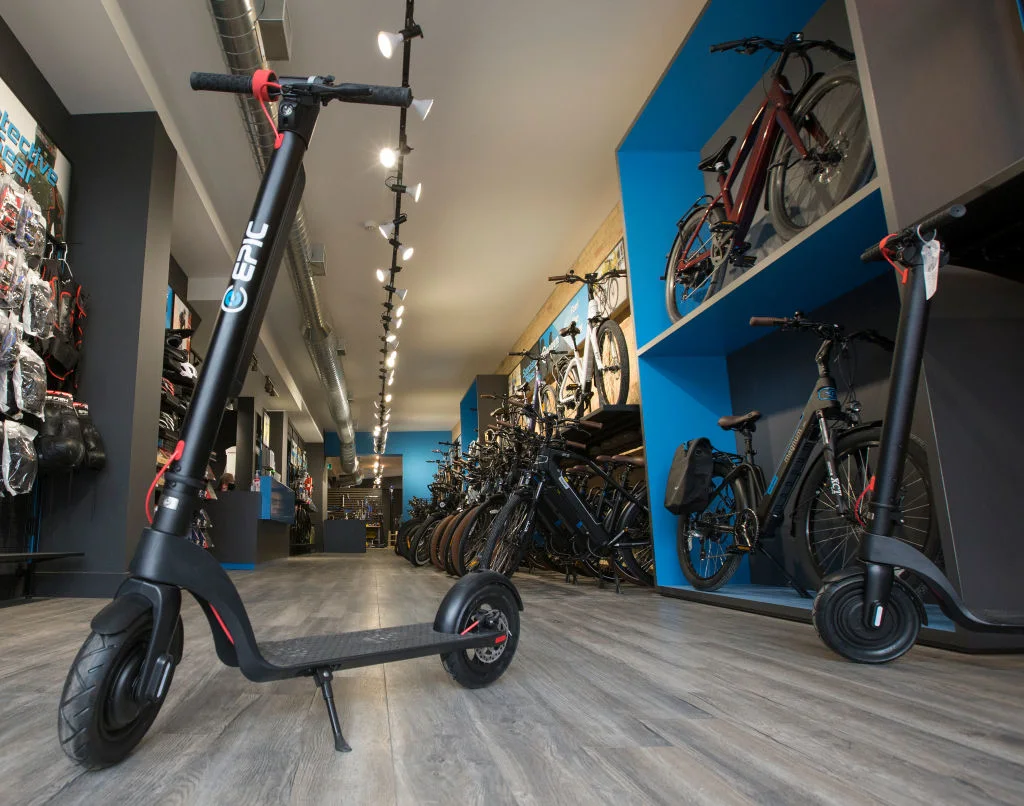
Boom in e-bikes and scooters has potential to put a big dent in emissions
Commuters are shifting toward e-bikes and scooters despite worries and city bans.
Amid rising gas prices this year, many commuters have made the switch to e-bikes and scooters, a move that has potential to drastically slash emissions in the process.
This new transportation trend has caught on in major Canadian cities, with the comparably affordable price of e-bikes and scooters seen by many customers as a way to offset historically high costs at the pumps.
Other converts have been won over by the flexibility e-bikes and scooters offer in terms of parking, storage, and navigability in traffic.

An EPIC X8, an introduction level e-scooter. (Rick Madonik/Toronto Star/ Getty Images)
“I choose to ride my scooter because it’s practical, easy and affordable,” Thales Filho, a Toronto-based e-scooter commuter, told The Weather Network. “For me it is the best way to commute, and you don’t need to worry about parking or traffic.”
“It takes far less time for me to scooter to do my errands,” Filho added. “I’m spending more money with gas right now as well, which is another advantage of the scooters: they don’t require much maintenance or gas.”
But an indirect benefit of this transportation evolution, which many riders are embracing, is to the environment.
A study released earlier this year determined that the CO2 emissions produced by the energy required to run e-bikes average about 22 g/km, while gas-powered cars emit more than 250 g/km.
The research, which focused on e-bike use in England, determined that 24.4 million tons of CO2 emissions could be avoided by adopting a greater use of e-bikes, or a savings of as much as 750 kg of CO2 per person yearly.
“After realizing how sustainable the scooters are and also how far you can go using them, definitely being eco-friendly plays a role now,” said Filho.
“Environmentally, it's far cheaper and efficient than my car and is often much faster as I can take alternative back routes,” added Kabir Bageria, a TWN video journalist who also commutes via e-scooter.
Watch below: Is your gas stove polluting your health and home?
The emissions-reduction potential of e-bikes and scooters is being embraced by some jurisdictions at the policy level as well.
“As part of the CleanBC Roadmap to 2030, we’re encouraging ‘mode shifting’ to energy efficient active transportation, such as walking, cycling or rolling using e-bikes, scooters or other mobility devices,” B.C.’s Ministry of the Environment told TWN in a statement.
They added that “e-bikes, or motor assisted cycles, are increasingly popular,” and as such they have implemented policies like eliminating PST on e-bikes and investing $60 million over three years on active transportation infrastructure programs.
B.C. also has the SCRAP-IT program, which is “designed to remove eligible vehicles from our roads and replace them with zero-emission vehicles or other non-emitting transportation mode options.”
Customers purchasing a new e-bike could get back up to $750 from SCRAP-IT via rebate.
But the rise of e-bikes and scooters has not been without controversy.

An electric scooter. (Storyblocks)
Over the summer, reports emerged that some cyclists and pedestrians in Montreal were worried about the dangers of e-bikes, especially when used on bike paths — even as the province’s auto insurance board completes a pilot program to determine ways to better accommodate e-bikes and scooters on the roadways.
Complaints about the dangers or unsightliness of e-bikes and scooters have been sounded in many other cities as well, including Singapore, San Francisco, and Chattanooga, which instituted a temporary ban due to safety concerns.
In part because of such worries, Toronto’s city council has refused to join an ongoing province-wide pilot program — which helped cities like Waterloo, Ontario establish rules for speed limits and helmet requirements — and continues to maintain a ban on the use of scooters “on any public street in Toronto including bicycle lanes, cycle tracks, trails, paths, sidewalks or parks.”
See also: How much money do you actually get back from the carbon tax?
This hasn’t slowed the meteoric growth in e-bike and scooter sales in the city, according to Caelan Ho, Manager of NIU Toronto, an e-bike and scooter shop on College Street.
“Since our opening in January of this year to the month of August, we’ve seen a two times multiple increase in gross sales each month,” Ho told TWN.
“Especially where the Downtown Toronto core is densely populated, people have slowly started to realize that there are more efficient ways to get around the city,” Ho added. “I personally use a NIU UQi+ electric bicycle to commute to work every day, to deliver food and deliver goods for my business.”

Caelan Ho, manager of NIU Toronto. (Kabir Bageria)
The boom in this country is modest, however, compared to other parts of the world.
According to reports by the International Energy Agency and Bloomberg New Energy Finance (BNEF), it is two- and three-wheeled vehicles that are driving the global EV sales boom, and the bulk of those purchases are happening in countries like China, India, and Vietnam.
While EV passenger vehicles made huge gains over the past few years and now make up nine per cent of the global car market (or 16.7 million vehicles), two- and three-wheeled EVs have exploded to reach 42 per cent of the global small vehicle market (or 242.7 million vehicles), according to BNEF.
In these countries, where smaller vehicles are already much more embedded in the transportation system, there has been far less resistance.
According to some in the industry, it is only a matter of time before acceptance of e-bikes and scooters becomes the norm here too.
“As the City of Toronto continues to improve their cycling infrastructure and electric scooter companies continue to lobby for the legality of electric scooters,” Ho said, “this trend of micro-mobility vehicles is here to stay and is revolutionizing the way we define urban transportation.”
Thumbnail image: A man using an electric scooter. (Nico De Pasquale Photography/ DigitalVision/ Getty Images)











